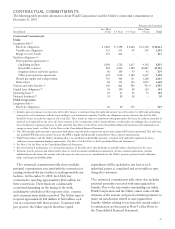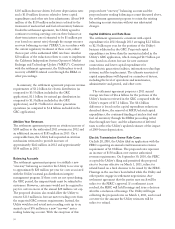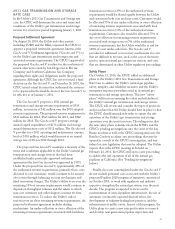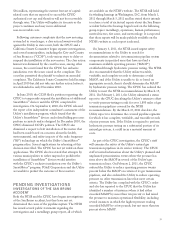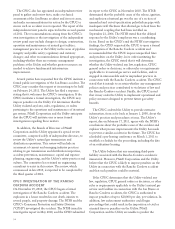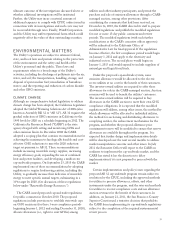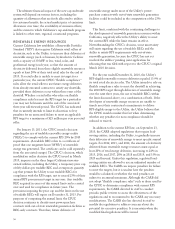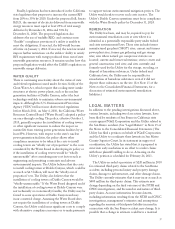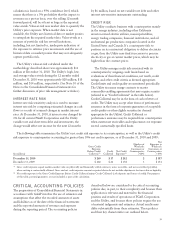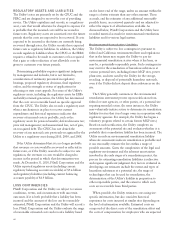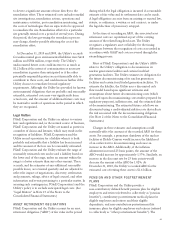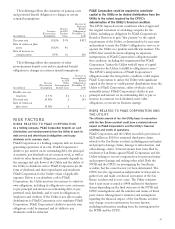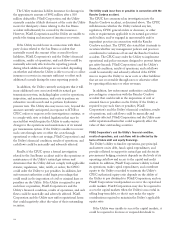PG&E 2010 Annual Report Download - page 41
Download and view the complete annual report
Please find page 41 of the 2010 PG&E annual report below. You can navigate through the pages in the report by either clicking on the pages listed below, or by using the keyword search tool below to find specific information within the annual report.Finally, legislation has been introduced in the California
state legislature that proposes to increase the current RPS
from 20% to 33% by 2020. Under the proposed bill, Senate
Bill 23, the amount of electricity delivered from renewable
energy resources must equal at least 25% of total energy
deliveries by December 31, 2016 and 33% by
December 31, 2020. The proposed legislation also
addresses the use of tradable RECs and contains some
“flexible” compliance provisions if a utility is unable to
meet the obligations. If enacted, the bill would become
effective on January 1, 2012. If enacted, the new law would
impose further restrictions on the utilities’ ability to satisfy
RPS requirements with energy produced from out-of-state
renewable generation resources. It remains unclear how this
proposed legislation would affect the CARB’s regulation on
renewable energy deliveries.
WATER QUALITY
There is continuing uncertainty about the status of state
and federal regulations issued under Section 316(b) of the
Clean Water Act, which require that cooling water intake
structures at electric power plants, such as the nuclear
generation facilities at Diablo Canyon, reflect the best
technology available to minimize adverse environmental
impacts. Although the U.S. Environmental Protection
Agency (“EPA”) will not issue draft revised regulations
before March 2011, on May 4, 2010, the California Water
Resources Control Board (“Water Board”) adopted a policy
on once-through cooling. The policy, effective October 1,
2010, generally requires the installation of cooling towers
or other significant measures to reduce the impact on
marine life from existing power generation facilities by at
least 85%. However, with respect to the state’s nuclear
power generation facilities, the policy allows other
compliance measures to be taken if the costs to install
cooling towers are “wholly out of proportion” to the costs
considered by the Water Board in developing its policy or
if the installation of cooling towers would be “wholly
unreasonable” after considering non-cost factors such as
engineering and permitting constraints and adverse
environmental impacts. The Utility believes that the costs
to install cooling towers at Diablo Canyon, which could be
as much as $4.5 billion, will meet the “wholly out of
proportion” test. The Utility also believes that the
installation of cooling towers at Diablo Canyon would be
“wholly unreasonable.” If the Water Board disagreed and if
the installation of cooling towers at Diablo Canyon were
not technically or economically feasible, the Utility may be
forced to cease operations at Diablo Canyon and may
incur a material charge. Assuming the Water Board does
not require the installation of cooling towers at Diablo
Canyon, the Utility could incur significant costs to comply
with alternative compliance measures or to make payments
to support various environmental mitigation projects. The
Utility would seek to recover such costs in rates. The
Utility’s Diablo Canyon operations must be in compliance
with the Water Board’s policy by December 31, 2024.
REMEDIATION
The Utility has been, and may be, required to pay for
environmental remediation costs at sites where it is
identified as a potentially responsible party under federal
and state environmental laws. These sites include former
manufactured gas plant (“MGP”) sites; current and former
power plant sites; former gas gathering and gas storage
sites; sites where natural gas compressor stations are
located; current and former substations; service center and
general construction yard sites; and sites currently and
formerly used by the Utility for the storage, recycling, or
disposal of hazardous substances. Under federal and
California laws, the Utility may be responsible for
remediation of hazardous substances even if it did not
deposit those substances on the site. (See Note 15 of the
Notes to the Consolidated Financial Statements, for a
discussion of estimated environmental remediation
liabilities.)
LEGAL MATTERS
In addition to the pending investigations discussed above,
various lawsuits, including two class action lawsuits, have
been filed by residents of San Bruno in California state
courts against PG&E Corporation and the Utility related to
the San Bruno accident. (See “Legal Matters” in Note 15 of
the Notes to the Consolidated Financial Statements.) The
Utility has filed a petition on behalf of PG&E Corporation
and the Utility to coordinate these lawsuits in San Mateo
County Superior Court. In its statement in support of
coordination, the Utility has stated that it is prepared to
enter into early mediation in an effort to resolve claims
with those plaintiffs willing to do so. A hearing on the
Utility’s petition is scheduled for February 24, 2011.
The Utility recorded a provision of $220 million in 2010
for estimated third-party claims related to the San Bruno
accident, including personal injury and property damage
claims, damage to infrastructure, and other damage claims.
The Utility currently estimates that it may incur as much as
$400 million for third-party claims. This estimate may
change depending on the final outcome of the NTSB and
CPUC investigations, and the number and nature of third-
party claims. As more information becomes known,
including information resulting from the NTSB and CPUC
investigations, management’s estimates and assumptions
regarding the amount of third-party liability incurred in
connection with the San Bruno accident may change. It is
possible that a change in estimate could have a material
37


